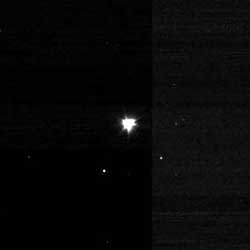
Deep Impact took this image of its own impactor drifting away from the spacecraft. Image credit: NASA/JPL. Click to enlarge.
One hundred and seventy-one days into its 172-day journey to comet Tempel 1, NASA’s Deep Impact spacecraft successfully released its impactor at 11:07 p.m. Saturday, Pacific Daylight Time (2:07 a.m. Sunday, Eastern Daylight Time).
At release, the impactor was about 880,000 kilometers (547,000 miles) away from its quarry. The separation of flyby spacecraft and the washing-machine-sized, copper-fortified impactor is one in a series of important mission milestones that will cap off with a planned encounter with the comet at 10:52 p.m. Sunday, PDT (1:52 a.m. on July 4, EDT).
Six hours prior to impactor release, the Deep Impact spacecraft successfully performed its fourth trajectory correction maneuver. The 30-second burn changed the spacecraft’s velocity by about one kilometer per hour (less than one mile per hour). The goal of the burn is to place the impactor as close as possible to the direct path of onrushing comet Tempel 1.
Soon after the trajectory maneuver was completed, the impactor engineers began the final steps that would lead to it being ready for free flight. The plan culminated with activation of the impactor’s batteries at 10:12 p.m., PDT (1:12 a.m. Sunday, EDT). Deep Impact’s impactor has no solar cells; the vehicle’s batteries are expected to provide all the power required for its short day-long life.
In order to release the impactor, separation pyros fired allowing a spring to uncoil and separate the two spacecraft at a speed of about 35 centimeters per second (0.78 mile per hour).
With Tempel 1 closing the distance between it and impactor at about 10 kilometers (6 miles) per second, there is little time for mission controllers to admire their work. Twelve minutes after impactor release the flyby began a 14-minute long divert burn that slowed its velocity relative to the impactor by 102 meters per second (227 miles per hour), moving it out of the path of the onrushing comet nucleus and setting the stage for a ringside seat of celestial fireworks to come less than 24 hours later.
Deep Impact mission controllers have confirmed the impactor’s S-band antenna is talking to the flyby spacecraft. All impactor data including the expected remarkable images of its final dive into the comet’s nucleus will be transmitted to the flyby craft — which will then downlink them to Deep Space Network antennas that are listening 134 million kilometers (83 million miles) away.
While all is going as expected on the Deep Impact spacecraft the comet itself is putting on something of a show. The 14-kilometer-long (8.7-mile-long) comet Tempel 1 displayed another cometary outburst on July 2 at 1:34 a.m. PDT (4:34 a.m.EDT) when a massive, short-lived blast of ice or other particles escaped from inside the comet’s nucleus and temporarily expanded the size and reflectivity of the cloud of dust and gas (coma) that surrounds it. The July 2 outburst is the fourth observed in the past three weeks.
Three of the outbursts appear to have originated from the same area on the surface of the nucleus but they do not occur every time that that area faces the Sun.
“The comet is definitely full of surprises so far and probably has a few more in store for us,” said Deep Impact Project Manager Rick Grammier of NASA’s Jet Propulsion Laboratory, Pasadena, Calif. “None of this overly concerns us nor has it forced us to modify our nominal mission plan.”
Information and images from a camera aboard Deep Impact’s impactor and flyby spacecraft can be watched in near-real time at http://www.nasa.gov/deepimpact.
For additional information about Deep Impact on the Internet, visit NASA Deep Impact.
Original Source: NASA News Release
